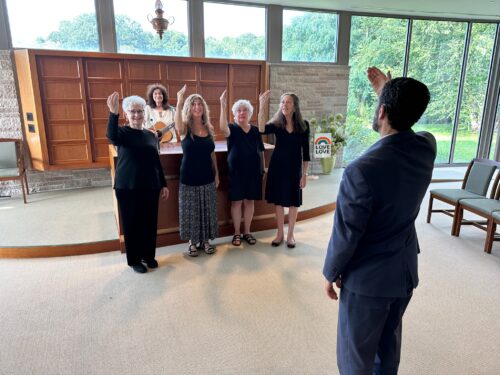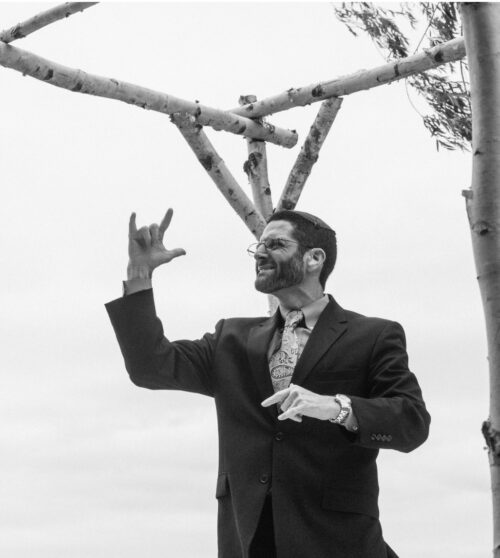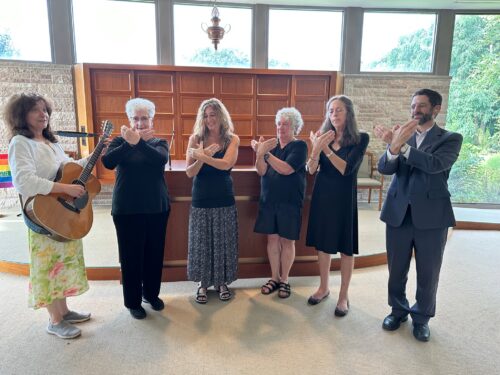The cantor’s final notes echoed through the sanctuary, and a hush fell over the congregation—while the rabbi continued conducting, guiding the ASL choir as they gracefully delivered an additional piece of liturgy, silently bringing the prayer to its completion.
Living its values—kehillah (community), simchah (joy), and k’vod ha-b’riyot (respect for the dignity of every person), is what Kerem Shalom, a progressive synagogue in Concord, is all about. Being inclusive is at the heart of its mission, and there is a fervent belief that there can only be true community when all are included and programming is accessible.
When Rabbi Darby Leigh (affectionately known as Rabbi Darby) joined the community 10 years ago, he became one of only two U.S. rabbis who are Deaf to lead hearing congregations. “I thought it would be wonderful to serve a synagogue where there was enough American Sign Language (ASL) awareness, where enough people knew ASL, that we could lead some community prayer through ASL,” shares Leigh. “Sing and sign include the same letters. They’re very similar words. I had a sense that this community would appreciate it if instead of your voice being the instrument of prayer— you literally put the words into your hands, arms, face, and shoulders—ASL liturgy is a true embodiment of prayer. It is a profoundly different feeling of prayer and praying.”

Kerem Shalom began offering ASL classes as a precursor to creating an ASL Choir, as choir participants are required to have at least a rudimentary knowledge of ASL. “We wanted participants to have a close interest in learning about Deaf community, Deaf culture and language because I’m walking a tightrope with the ASL Choir,” Leigh reflects. “The Deaf community can be offended by hearing people producing musical mediums in ASL on social media, as there’s often no Deaf cultural connection. When done that way, it becomes a form of cultural appropriation, which we strive to avoid. Some of our members use ASL in their personal lives or professional lives, some have long since had a deep interest in ASL and, of course, some were newcomers to ASL.”
Starting in the summer of 2017, choir members began to sign their first prayer, an undertaking that has evolved into an annual tradition. Each year, Rabbi Darby pre-selects a few pieces of liturgy that he plans to use over the High Holy Days in the fall. Choir members meet a few times, choose a prayer, and then translate it from Hebrew into English and then into ASL. “The conversation is rich and deep as we work to convey authentic meaning in ASL,” muses Rabbi Darby. “ASL is a language with its own grammar and syntax. We are really trying to capture the meaning of the liturgy and to create a true translation together by consensus—not a word-for-word translation.”
Once the ASL translation has been committed to memory, Kerem Shalom Cantor Rosalie Gerut introduces an additional layer by infusing the prayers with her melodious voice, following the choir’s ASL, striving to achieve harmony through synchronization. “If we can get the timing right—that’s magic,” exclaims Rabbi Darby. And then each fall, during High Holy Days services, the choir unveils a brand-new ASL translation to a piece of liturgy or prayer, which then becomes part of its repertoire. “Witnessing the transcendent beauty of the ASL movement of hands, arms, and fingers during the musical chanting of our Judaic prayers is deeply inspiring,” says Gerut.

When the ASL Choir prays with the congregation, the production of sacred liturgy in a visual medium offers a moving experience. “If, for the first time, you see the Shema or other sacred prayer in a visual language, you may have a profoundly moving and deeper experience of our sacred prayers,“ comments Rabbi Darby. “We are looking for souls we can reach by offering sacred Hebrew liturgy in a visual medium. I’ve seen people say, ‘I never imagined what that prayer could look like,’ and then they become truly inspired by it and sometimes even interested in learning ASL.”
ASL Choir members speak from the heart when relating their experiences signing. Laura Heideman shares, “The ASL Choir has been a spiritual anchor since we began with Rabbi Darby. Translating Hebrew into ASL allows me to understand the meaning of the prayers I recite. Reciting them with others brings me to a deeper spiritual level.” Member Marla Richmond adds, “If you watch ASL with your heart, you know what the words mean.” Member Iris Barten concurs, “With my background working with individuals who are living with medical and developmental challenges, I felt drawn to be in the ASL Choir from the beginning. This is one of the most meaningful spiritual decisions I’ve made in my life. The ASL signs express a spiritual essence…a sense of emotions, movement, directionality, and relationship with Adonai (God). Signing the prayers brings a dimension of embodiment that enhances my spirituality while also bringing forth an accessible way to engage in prayer with our community.”

Rabbi Darby is especially proud that Kerem Shalom walks the talk. It has not only made inclusiveness part of its mission, it has taken it to the next level. From the ASL Choir taking part in many Shabbat services throughout the year, to interpreters at numerous services and events, to Hebrew School Reimagined students learning to sign “Shalom Chaverim” at the end of every school community gathering—”We’re living our values.”
Rabbi Darby hopes the ASL Choir inspires others in the community to study ASL and even consider joining the choir. And Kerem Shalom’s ASL Choir looks forward to debuting a new piece of liturgy at the High Holy Days 5784, which begin at sundown on Friday, Sept. 15.
Learn more about Kerem Shalom at kereshalom.org.
This post has been contributed by a third party. The opinions, facts and any media content are presented solely by the author, and JewishBoston assumes no responsibility for them. Want to add your voice to the conversation? Publish your own post here. MORE


